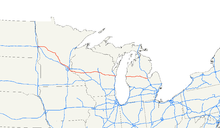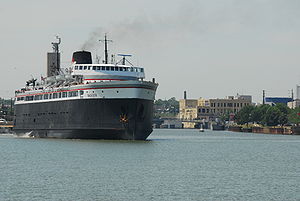- SS Badger
-
The SS Badger getting underway from Manitowoc, WisconsinCareer (USA) Name: SS Badger Namesake: University of Wisconsin Owner: Lake Michigan Carferry Service Route: Ludington, MI–Manitowoc, WI Builder: Christy Corporation, Sturgeon Bay, WI Yard number: Hull No. 370 Launched: 6 September 1952 Sponsored by: Mrs. Walter J. Kohler (wife of Governor of Wisconsin) In service: 21 March 1953 Homeport: Ludington, MI Identification: Official No. 265156
IMO number: 5033585Nickname: "The Big Badger" (Charles F. Conrad's favorite description) Status: Active General characteristics Type: Passenger and automobile car ferry Tonnage: 4,244 gross tons Length: 410 ft 6 in (125.12 m) Beam: 59 ft 6 in (18.14 m) Depth: 24 ft (7.32 m) molded depth Installed power: Steam, coal-fired Propulsion: Two compound Skinner Unaflow steam engines, totaling 7,560 hp (5.64 MW); four Foster-Wheeler water-tube type D boilers, 450 psi (3.10 MPa) Speed: 18 mph (15.6 kn; 29.0 km/h) Capacity: 620 passengers, 180 automobiles, also tour buses, RVs, motorcycles, and commercial trucks Crew: 50–60 Notes: SS BadgerLocation: 700 S. Williams Street
Ludington, MichiganCoordinates: 43°56′57″N 86°27′04″W / 43.94917°N 86.45111°WCoordinates: 43°56′57″N 86°27′04″W / 43.94917°N 86.45111°W NRHP Reference#: 09000679[1] Significant dates Added to NRHP: December 11, 2009 Designated MSHS: March 6, 1997[2]  The S.S. Badger connects the eastern and western segments of U.S. Route 10, shown here in red.
The S.S. Badger connects the eastern and western segments of U.S. Route 10, shown here in red.
The SS Badger is a coal-fired passenger and vehicle ferry in the United States that has been in Lake Michigan service from 1953 until the present. Currently, she shuttles between Ludington, Michigan and Manitowoc, Wisconsin. She is the last coal-fired passenger vessel operating on the Great Lakes.
The boat is named after the University of Wisconsin's athletic mascot,[3] "Bucky Badger". The Badger runs on Michigan time (Eastern Standard/Daylight Time, whereas Wisconsin is in the Central time zone) and riders pay Michigan taxes on their fares.
Contents
Background
The Badger was constructed as a rail car ferry in 1952–53 by the Christy Corporation of Sturgeon Bay, Wisconsin,[3] along with her twin sister the SS Spartan (the mascot of Michigan State University) with a reinforced hull for ice-breaking. She was originally used to carry railroad cars, passengers and automobiles between the two sides of the lake all year long. Today the ferry connects the eastern and western segments of U.S. Route 10 in the two cities from May to October.
Launched 6 September 1952, the S.S. Badger entered service 21 March 1953 for the Chesapeake and Ohio Railway (from 1973 a subsidiary of the Chessie System). The C&O had acquired the rail car ferry operations in Ludington with its acquisition of the Pere Marquette Railway in 1947.[4] After 1972 service was gradually curtailed; all but the three newest vessels were retired, and sailings to Milwaukee, Wisconsin and Manitowoc, Wisconsin were discontinued, leaving only the route between Ludington and Kewaunee, Wisconsin. On 1 July 1983, the Chessie System ended its car ferry service when it sold the steamers Badger, Spartan, and City of Midland 41 to Glen F. Bowden of Ludington. He organized the Michigan-Wisconsin Transportation Company (MWT) to continue the operation.[5]
The railroad car ferry concept on Lake Michigan was facing serious economic troubles during the 1980s and by November 1988 the Badger was the only vessel running. She was the last of the fourteen ferries since 1897 based in Ludington remaining in service.[3] On 16 November 1990, facing bankruptcy, Bowden laid up the Badger, ending 93 years of railway car ferry service out of Ludington and 98 years on Lake Michigan as a whole.[6]
Lake Michigan Carferry Service
After sitting idle for a year, the three ferries were purchased by entrepreneur and philanthropist Charles F. Conrad of Holland, Michigan, (and a native of Ludington). He undertook a major overhaul and refit of the Badger exclusively for carrying passengers and automobiles. Returning to service 16 May 1992, on the Ludington-Manitowoc route, the vessel has carried hundreds of thousands of passengers and vehicles across the lake. She is the only operating ferry of her kind in the world and is an icon of car ferry heritage on the Great Lakes.[7]
Conrad retired as president of Lake Michigan Carferry Service in 1993. He died on 9 February 1995. Since 1993 the company has been headed by his son-in-law, Robert Manglitz.[8]
The Badger is the last large coal burning steamship in the United States and is one of the last vessels in service on the Great Lakes to be powered by Skinner Unaflow engines (manufactured by the Skinner Company of Erie, Pennsylvania).[9] The Badger makes a dock 490 times a year on her schedule as of 2009, an exceptionally large number of dockings for a merchant vessel.
On average, the Badger completes a trip across Lake Michigan in about four hours, covering 60 miles (97 km).[10] The ferry saves about three and a half hours of travel time (and the frustration of congested highways) compared to the 411-mile (661 km) drive from Manitowoc to Ludington via Chicago. The ferry offers a number of entertainment options and eating facilities on board, as well as passenger staterooms equipped with sleeping berths. Because of her size and strong construction the SS Badger rarely misses a sailing because of weather related delays.[citation needed]
The SS Badger is also unusual in that it is a registered historical site in two states. The Michigan Historical Commission and the Wisconsin Historical commission each named the Badger as a registered historical site in 1997. She was listed as of national significance on the National Register of Historic Places on December 11, 2009.
On 9 August 2008, the Badger suffered a stern bearing failure, causing the company to cancel the ferry's sailings for nearly a week. It was the first time the ship had ever experienced a stern bearing failure. On 10 August she sailed under her own power to the Bay Shipbuilding yard in Sturgeon Bay for repairs. As there was no opening at the time for the work to be done in the dry dock, a team of divers was flown in from California to assist in the repairs. Regular sailings resumed 15 August 2008. It was the first time since 1994 (when she struck a rock at Ludington) that the Badger was laid up for unscheduled repairs, and the first time since 2005 that the company canceled a sailing because of mechanical failure[citation needed].
Efforts to improve environmental impact
The SS Badger has the tough task of balancing the need to preserve a historic ship with the need to minimize environmental impact. The SS Badger came under fire from the Environmental Protection Agency (EPA) and environmental groups in late 2008 because of its daily practice of dumping untreated coal ash from its boilers directly into the waters of Lake Michigan. Coal ash is a byproduct of the Badger's propulsion system but is also used in farming applications, such as feedlots where livestock are fed. In a North Dakota State University study, coal ash runoff did not present any toxins to humans or animals beyond the acceptable standards. (The Badger had earlier been the subject of EPA Clean Air action but was granted an exemption from regulation.) West Michigan Carferry President and CEO Bob Manglitz has rebuffed the EPA demand that Badger find a way to capture and safely offload ash, change the fueling configuration of the ship, or cease operations by 2012. Manglitz has frequently equated coal ash to "harmless sand" and vowed to keep the Badger in its original coal-burning configuration.[11] In an effort to continue to minimize the environmental impact to the lake, the SS Badger has explored a number alternatives including, storing the ash on board and unloading upon arrival in Ludington. Another option being considered is the use of compressed natural gas, this would allow the historical boiler system to be maintained and making the SS Badger the first "green" ship on the Great Lakes.
Images
-
Dock ticket office in Manitowoc, Wisconsin.
References
- ^ "National Register Information System". National Register of Historic Places. National Park Service. 2009-03-13. http://nrhp.focus.nps.gov/.
- ^ State of Michigan (2009). "S.S. BADGER". http://www.mcgi.state.mi.us/hso/sites/65004.htm. Retrieved June 26, 2010.
- ^ a b c Sign at Manitowoc Ferry dock, Retrieved 30 July 2007
- ^ Chavez, Art (2003). S.S. Badger. The Great Lakes Car Ferry. Charleston, S.C.: Arcadia Publishing. pp. 26–51 passim.. ISBN 0-7385-2304-6.
- ^ Chavez, 2003, p. 79.
- ^ Chavez, 2003, pp. 87-88.
- ^ Chavez, 2003, pp. 89-91.
- ^ Chavez, 2003, p. 91.
- ^ The 1906 lake freighter St Mary's Challenger, another steamship still in service on Lake Michigan also has Skinner Unaflow engines, fitted during a refit in 1950."Great Lakes Fleet Page Vessel Feature – St. Marys Challenger". http://www.boatnerd.com/pictures/fleet/stmaryschallenger.htm. Also the Canadian lakes steamer, James Norris, has Unaflow engines.
- ^ Staff (2006). "S.S. Badger: Big Ship, More Fun!". Lake Michigan Carferry. http://www.ssbadger.com. Retrieved 2006-07-25.
- ^ WLUK-TV report, June 2, 2009
Bibliography
- Chavez, Art (2003). S.S. Badger. The Great Lakes Car Ferry. Charleston, S.C.: Arcadia Publishing. ISBN 0-7385-2304-6.
- John O. Greenwood, Namesakes of the '80's, Volume II. Cleveland, Ohio: Freshwater Press, Inc., 1984. ISBN 0-9125-14-28-0
- George W. Hilton, The Great Lakes Car Ferries. Berkeley, Calif.: Howell-North Books, 1962.
- Karl Zimmermann, Lake Michigan's Railroad Car Ferries. Andover, N.J.: Andover Junction Publications, 1993. ISBN 0-944119-11-5
- Debra Pflughoeft-Hassett, EERC; Vern Anderson, CREC; "Stabilizing Feedlots Using Coal Ash". University of North Dakota, 2002.
Project Management:
External links
Categories:- Ferries of Michigan
- Ferries of Wisconsin
- Manitowoc County, Wisconsin
- National Register of Historic Places in Michigan
- Michigan State Historic Sites
- Mason County, Michigan
- U.S. Route 10
- Chesapeake and Ohio Railway
- Train ferries
- 1952 ships
- Lake Michigan Circle Tour
-
Wikimedia Foundation. 2010.




